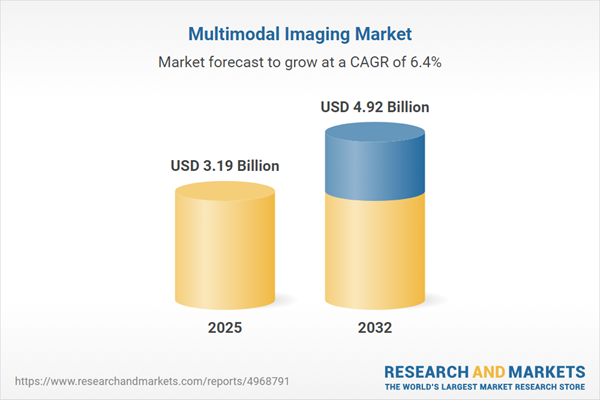Speak directly to the analyst to clarify any post sales queries you may have.
The multimodal imaging market is advancing rapidly, fueled by innovation, collaboration, and emerging technologies that transform diagnostic practices across healthcare and research environments. Senior decision-makers seeking actionable direction will benefit from understanding evolving integration trends and strategic opportunities in this sector.
Market Snapshot: Multimodal Imaging Market in Focus
The multimodal imaging market is experiencing consistent growth, with revenues rising from USD 3.00 billion in 2024 to USD 3.19 billion in 2025, and a projected CAGR of 6.37% set to propel the industry to USD 4.92 billion by 2032. Driving factors include rising standards in diagnostic precision, greater focus on hybrid imaging technologies, and increased demand for comprehensive patient information for tailored treatment regimens.
Scope & Segmentation: Comprehensive Insights Across Modalities & Regions
This report provides detailed coverage of the multimodal imaging market, outlining strategic segmentations and regional perspectives critical for informed decision-making:
- Component: Hardware, Services, Software
- Imaging Modality: PET CT, PET MR, SPECT CT
- Application: Cardiovascular, Neurology, Oncology
- End User: Academic Institutes, Diagnostic Imaging Centers, Hospitals, Research Institutes
- Region: Americas (United States, Canada, Mexico, Brazil, Argentina, Chile, Colombia, Peru), Europe, Middle East & Africa (United Kingdom, Germany, France, Russia, Italy, Spain, Netherlands, Sweden, Poland, Switzerland, UAE, Saudi Arabia, Qatar, Turkey, Israel, South Africa, Nigeria, Egypt, Kenya), Asia-Pacific (China, India, Japan, Australia, South Korea, Indonesia, Thailand, Malaysia, Singapore, Taiwan)
- Leading Companies: General Electric Company, Siemens Healthineers AG, Koninklijke Philips N.V., Canon Medical Systems Corporation, Fujifilm Holdings Corporation, PerkinElmer, Inc., Bruker Corporation, United Imaging Healthcare Co., Ltd., Mediso Medical Imaging Systems Ltd., MR Solutions Ltd.
Key Takeaways: Strategic Insights for Decision-Makers
- Hybrid scanners and integrated protocols are increasingly adopted to enable precise treatment planning and enhanced monitoring of patient therapies.
- Artificial intelligence and machine learning algorithms are powering the synthesis of anatomical and functional imaging data, supporting early disease detection and predictive analytics.
- Collaborations among manufacturers, academic institutions, and pharmaceutical companies are catalyzing the development of specialized tracers and interoperable biomarker standards.
- Operational resilience, particularly in responding to policy and supply chain shifts, is now central to business strategy and long-term competitiveness.
- Regional trends indicate varying priorities, with established markets advancing clinical trials and technology, and emerging regions investing in capacity building and public-private partnerships.
- Comprehensive service models that combine equipment, analytics, and training are increasingly valued over transactional product offerings, underscoring an industry shift toward outcome-oriented relationships.
Tariff Impact: Adjusting Strategy in Response to U.S. Policy Shifts
Recent U.S. tariffs on imported imaging components have introduced new cost pressures and driven shifts in procurement and supply chain strategy across the multimodal imaging landscape. Manufacturers are mitigating exposures through local supplier partnerships, investment in domestic production, and strategic alliances to circumvent tariff barriers. Service providers and health systems are reevaluating capital expenditures and total cost of ownership, emphasizing lifecycle support and operational flexibility.
Methodology & Data Sources
This analysis employs a rigorous combination of qualitative and quantitative approaches. Sources include peer-reviewed literature reviews, expert interviews across radiology and manufacturing sectors, company reports, and regulatory filings. Analytical models integrate primary and secondary data, ensuring transparent, reproducible, and current insights.
Why This Report Matters
- Enables leaders to benchmark strategic opportunities in hybrid imaging, AI innovation, and collaborative development models.
- Guides operational decisions with in-depth segmentation analysis, regional insights, and actionable recommendations for supply chain and investment resilience.
- Supports effective market positioning through up-to-date profiles of leading companies, technology trends, and evolving policy frameworks.
Conclusion
The multimodal imaging market is shaped by technology integration, evolving collaborations, and adaptive supply strategies. Decision-makers can leverage the insights presented to steer innovation, strengthen partnerships, and secure sustainable growth in a dynamic global environment.
Additional Product Information:
- Purchase of this report includes 1 year online access with quarterly updates.
- This report can be updated on request. Please contact our Customer Experience team using the Ask a Question widget on our website.
Table of Contents
3. Executive Summary
4. Market Overview
7. Cumulative Impact of Artificial Intelligence 2025
List of Figures
Samples

LOADING...
Companies Mentioned
The key companies profiled in this Multimodal Imaging market report include:- General Electric Company
- Siemens Healthineers AG
- Koninklijke Philips N.V.
- Canon Medical Systems Corporation
- Fujifilm Holdings Corporation
- PerkinElmer, Inc.
- Bruker Corporation
- United Imaging Healthcare Co., Ltd.
- Mediso Medical Imaging Systems Ltd.
- MR Solutions Ltd.
Table Information
| Report Attribute | Details |
|---|---|
| No. of Pages | 198 |
| Published | October 2025 |
| Forecast Period | 2025 - 2032 |
| Estimated Market Value ( USD | $ 3.19 Billion |
| Forecasted Market Value ( USD | $ 4.92 Billion |
| Compound Annual Growth Rate | 6.3% |
| Regions Covered | Global |
| No. of Companies Mentioned | 11 |









